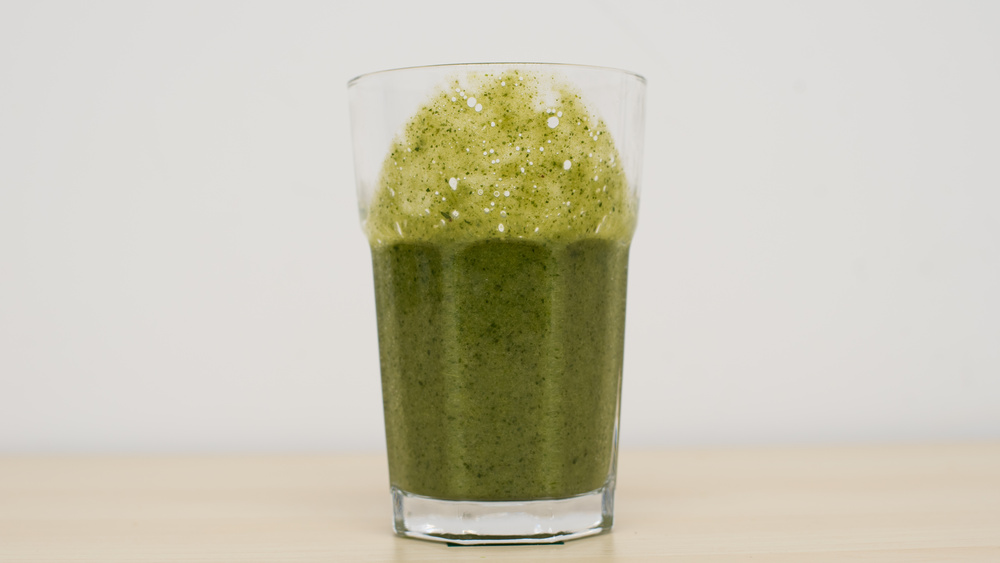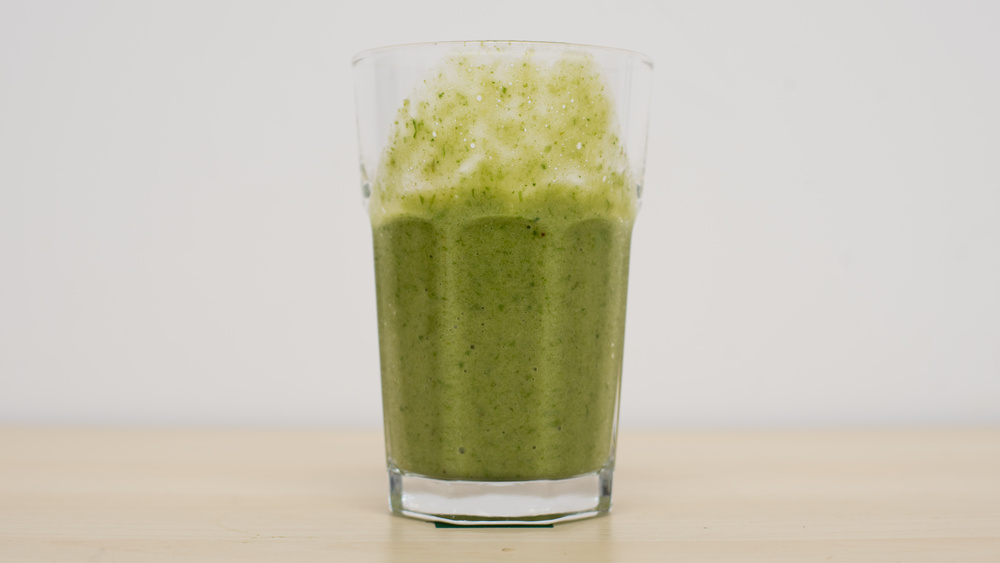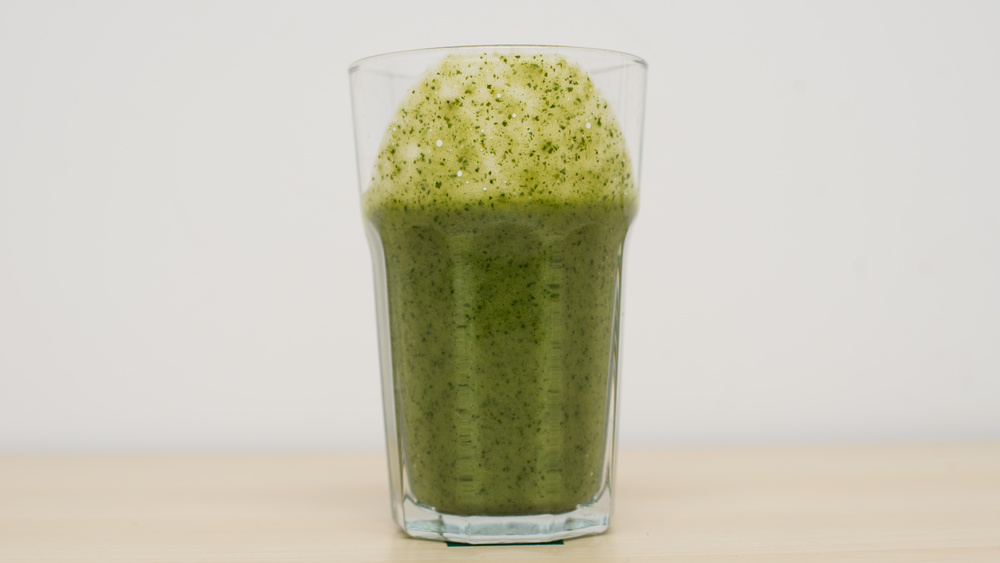- Table of Contents
- Intro
- Our Tests
- What's Not Included
- Conclusion
- Comments
Our Blender Performance Tests
Fibrous Ingredients
Fibrous ingredients include common smoothie additions like leafy greens and fruit like apples, blueberries, and pineapple. The best blenders for processing fibrous ingredients completely liquify your favorite healthy ingredients, so you never have to worry about getting a bit of kale stuck in your teeth. However, it's not just important for drinks like smoothies and protein shakes. Vegetables like broccoli are also fibrous, so if you plan to make pureed soups or sauces and want a perfectly smooth blend, it's important to find a blender that does a good job blending fibrous ingredients.
Test results
Our Tests
We blend kale, orange juice, and banana to test a blender's ability to process fibrous ingredients. Kale is a particularly stubborn ingredient, so if a blender can make a smooth kale smoothie, it can handle a variety of fibrous fruits and vegetables.
We consider two factors for a blender's overall score for fibrous ingredients (small batches) and fibrous ingredients (full capacity). The texture of the final blend makes up 80% of the final score, while the process—how easy and quick it is to use for fibrous ingredients—is 20%.
We test each blender's performance with small batches and at full capacity. This is particularly relevant for full-size blenders that only come with one jar. These blenders usually have a capacity between 48oz and 72oz and sometimes struggle to smoothly blend smaller amounts since ingredients can splash around instead of being pulled into a vortex.
That's not the case for all blenders—our best blender for smoothies, the Vitamix 5200, does a fantastic job of small batches, partly because of its narrow jar shape. If you want to make single-serve smoothies with a full-size blender, it's a good idea to check if it can handle smaller volumes of ingredients in the main jar or an included personal jar.
Jar Used (Small Batches)
We use a personal jar for the small batch test if one is available. Personal jars usually have a capacity between 13oz and 32oz. Otherwise, we use the pitcher that comes with a full-size blender or the beaker that comes with an immersion blender. For immersion blenders that don't come with a beaker, we use a standard 1000mL OXO beaker.
The same standard recipe and volume are always used, except for full-size blenders, where we may add some extra orange juice if the basic recipe doesn't cover the blades.
Processing (Small Batches)
Processing is about how easy and convenient it is to use a blender for smaller batches. Points are awarded or deducted based on how long it takes to achieve the smoothest possible blend as well as general ease of use.
To get a perfect score, a blender has to fully process the ingredients quickly, with no stirring, tamping, scraping, or shaking required. We can also deduct points for inconvenient controls, like a button you must keep constantly pressed to blend. Immersion blenders generally have lower processing scores since you have to hold the motor base and usually keep a button pressed.
Texture (Small Batches)
The texture score is assigned based on the photograph of the smoothie poured into a glass. To receive a perfect score, no unprocessed pieces must be left over in the final blend. Lower-scoring blenders have many bigger unprocessed bits of kale left over.
Smaller personal jars (with a capacity from around 18oz to 32oz) usually produce at least decent results. Most personal jars we've tested, whether they come with a personal or a full-size blender, can make a good kale smoothie. Battery-powered portable blenders are usually an exception since they aren't powerful enough to fully blend the ingredients. If you plan to buy a full-size blender with only one jar, checking how it performs with small batches is good. Some full-size blender pitchers perform worse with smaller amounts of ingredients because they splash up the sides of the jar.
Jar Used (Full Capacity)
Next, we test each blender's ability to process fibrous ingredients at full capacity. The main jar, which is also the biggest jar, is used for full-size blenders. The main jar is also used for personal blenders, and it's often the same jar used for the small batch. Immersion blenders are a little different—we use the included beaker or our own standard beaker filled to its full capacity. The same recipe of kale, orange juice, and bananas is used to test a blender's performance at full capacity, with the volume of ingredients scaled up to match the blender jar or beaker's max capacity.
Processing (Full Capacity)
The processing score for fibrous ingredients at full capacity is assigned the same way as the small batch processing score. For a blender to get a perfect score, it must fully process the ingredients quickly, without any stirring or shaking required.
Many full-size blenders perform better at full capacity since you don't run into the problem of ingredients splashing up the sides of the jar and getting stuck. However, some are much slower than others. Immersion blenders usually get a low score for processing fibrous ingredients at full capacity since they have difficulty pulling all the ingredients into a vortex, and you have to move the blender around constantly for the best results.
Texture (Full Capacity)
Like the previous test, the texture score is assigned based on a photo of the blended mixture poured into a glass. Some full-size blenders that struggle with smaller batches do a much better job when you fill the main jar to full capacity. Immersion blenders are usually less powerful and often make grainier blends that get lower scores. However, remember that cooked ingredients are softer, and you'll get smoother results with ingredients that are easier to blend than raw kale. In the same way, you might not notice a big difference between a blender that scores an 8 and one that scores a 10 if you don't make smoothies with a lot of fibrous ingredients.
What's Not Included
Since you probably won't recreate our exact recipe, know that you can get different results depending on your specific ingredients, the volume of ingredients, and how long you choose to blend. Some blenders that don't perform the best might suit your purposes if you mainly blend softer ingredients or don't mind some unprocessed bits.
Conclusion
You can check out a blender's fibrous ingredients performance if you want to know how well it can blend common blends like smoothies and soups. These tests can also give you an idea of how versatile a full-size blender is since not every blender performs the same way with smaller volumes of ingredients. If you're wondering how certain blenders perform, check out our comparison of Vitamix vs. Blendtec and Ninja vs. NutriBullet Blenders. If you're looking for a blender that can smoothly process fibrous ingredients, check out our lists of the best blenders for smoothies and the best blenders.







